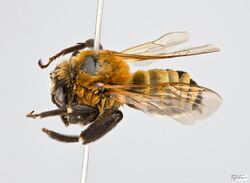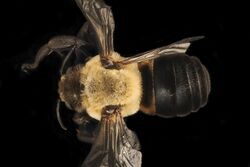Biology:Ptilothrix
| Ptilothrix | |
|---|---|

| |
| P. relata male | |
| Scientific classification | |
| Domain: | Eukaryota |
| Kingdom: | Animalia |
| Phylum: | Arthropoda |
| Class: | Insecta |
| Order: | Hymenoptera |
| Family: | Apidae |
| Tribe: | Emphorini |
| Genus: | Ptilothrix Smith, 1853.[1] |
Ptilothrix is a genus within the tribe Emphorini of the family Apidae (bumblebees, euglossines, honeybees, stingless bees). Bees of this genus can range from 7 to 15 millimeters. Ptilothrix species are solitary ground nesting bees. The genus has especially prominent leg hairs, called scopae, to help gather pollen to provision their nests. Ptilothrix specialize on certain families of plants for their pollen, including the families Malvaceae, Convolvulaceae, Onagraceae, Cactaceae, Pontederiaceae and Asteraceae. The genus is found in the new world, with species ranging from North to South America.
Species
The genus contains the following species:[2]
- Ptilothrix albidohirta
- Ptilothrix bombiformis (hibiscus bee, rose-mallow bee, eastern digger bee)
- Ptilothrix chacoensis
- Ptilothrix concolor
- Ptilothrix corrientium
- Ptilothrix fructifera
- Ptilothrix fuliginosa
- Ptilothrix heterochroa
- Ptilothrix lynchii
- Ptilothrix nemoralis
- Ptilothrix nigerrima
- Ptilothrix plumata
- Ptilothrix relata
- Ptilothrix scalaris
- Ptilothrix sumichrasti
- Ptilothrix tricolor
- Ptilothrix vulpihirta
Life History
Bees of the genus Ptilothrix are solitary. Unlike honeybees or other eusocial bee species, the members of Ptilothrix do not form a hive or have division of labor of individuals. Females nest individually in hard-packed soil and oviposit eggs into brood cells provisioned with masses of pollen and nectar, which provide nutrients for their offspring. The adults emerge from the nest, which is sometimes covered with a layer of soil to prevent predation. Predation in the larval stage is most commonly from parasitoid wasps, fire ants, and assassin flies, whose lifecycle is closely timed to that of P. plumata.[3] Due to the threat of predators and adverse environmental conditions, pupae can exhibit pupal diapause, or the ability to delay maturation until favorable environmental conditions occur. Some species will build their nests in dense aggregations in the same area.[4]
Males wait for females at flowers where they attempt to mate. Multiple studies have suggested that male aggression and mating behavior at flowers may contribute more to pollination of their host flowers than female visitation. One study found that while males accounted for 5% of pollen visits to Hibiscus flowers, they contributed over 20% of pollen grains deposited on anthers.[5] Therefore, male aggression contributes to increased pollination and seed set among Hibiscus.
Morphology
Bees of this genus are large and can range from 7 to 15 millimeters.
The coarse and long-haired scopa of the genus Ptilothrix aids them in collecting large-grained pollen, such as is found in the family Malvaceae. This may allow Ptilothrix species to thrive alongside other introduced species, such as honeybees, as it may reduce interspecific competition for pollen resources. Scopae are thought to have advantages in evapotranspiration and reflecting sunlight to keep bees cool in hot, arid environments in contrast to other members in the Apidae, such as honeybees and bumblebees, that have hairless pollen baskets (corbiculae) to carry their pollen on their legs. Ptilothrix species are able to walk on the surface of water while being supported by their legs.[4]
Range
Species of this genus are found in North and South America. Ptilothrix bombiformis is the only species east of the Mississippi River in North America. As with most bee taxa, they are most abundant at latitudes outside of the tropics.[6]
Nest construction
Ptilothrix are also referred to as the chimney bees, referring to the small chimney or turret of the nest entrance that can be seen on the soil surface. While specific nesting behavior varies by species, female members of this genus create ground nests in hard-packed soil. Nests can contain one to many brood cells, and in most species the female transports water to her nesting site to soften the soil for excavation. The female bee then digs a single-celled or multi-celled burrow, and lines the interior with wax or feces for support.[4]
A comprehensive comparison of nest construction and behavior between species can be found in Rust (1980)[4] and Martins et al. (1996)[3]. For P. bombiformis populations, nest survivorship averages about 57% of all nests created in a given season. The major causes of mortality in these populations appeared to be fungal pathogens or failure of the egg to hatch. Among P. plumata in Brazil, there is a high nest mortality rate of approximately 88% among nests that are completed in a season.[3] Predation by fire ants and other parasites are cited as the most likely causes. Females can make multiple nests and tend to avoid making nests in the rainy season.[4]
Females of this genus have evolved multiple behaviors to avoid predation. P. plumata showed a delayed dormancy in nests, with there being a bimodal presence of hatching in nests. This dormancy is in response to environmental conditions and predation. If a female noticed parasites or predators while constructing or visiting a nest, she would cover the nest or shake her body at the entrance to protect it.[3][7] Females have also been observed creating nests and abandoning construction before nests are complete.
Pollination
Bees exhibit a variety of behaviors for gathering pollen, with oligolecty being the typical behavior in Ptilothrix species. P. plumata, for example, is oligolectic towards pollen from plants in the family Malvaceae, with approximately 90% of pollen grains found in P. plumata nests from Pavonia species.[7]
Oligolecty was first defined by Robertson in 1925 to refer to those species that specialize on a family or group of closely related plant species. The alternatives to oligolecty are polylecty, generalization on a diverse range of plant species, and monolecty, which is strict specialization to a single plant species.[8][9]
There are benefits and disadvantages for this strategy, and there is also plasticity to oligolecty. When oligolectic bees are not given a choice of their preferred genus of host pollen plant, some can be opportunistic and forage on available plants.[9] Others are strict in their pollen diet choice and will not visit the flowers outside of their preferred pollen hosts.[8] This brings up the question of whether the bees are choosing not to visit the flowers because of factors related to incompatibility with the pollen, or do they simply not recognize the flowers as being sources of pollen?
Just because a bee is oligolectic to a particular plant species does not mean that it is the plant’s main pollinator. It is a distinction that brings up questions on the importance of specialists to pollination if generalists are filling the same role in pollination. Not surprisingly, the effectiveness of oligolecty depends on the species.[10] In some cases where pollen grains are large, they are more effectively carried by the specialist Ptilothrix.[11] In other cases, generalist bees are just as, if not more, effective; pollination effectiveness may have less to do with female pollen provisioning and more to do with male mating competition.[11] Additionally, the role of pollinators and plants as specialists or generalists within the community can change over seasons.[12] In some cases, generalist Bombus species are more effective pollinators of Malvaceae flowers than the specialist P. bombiformis. Also, it may not be in the specialist’s best interest to be an efficient pollinator since they typically want to provision as much pollen as possible in their nests and not lose it brushing up against a flower.[13]
Further reading
Recently, much attention has been placed on the importance of pollinators in meeting human needs, mostly focused on the pollination of food crops. Many citizen science organizations and conservation groups have published resources on native pollinators, and what people can do in their communities or in their own backyard. These resources include information on bee identification, native plantings that support pollinator habitat, and citizen science project resources.
- Ascher J.S., Pickering J. (2017) Discover Life bee species guide and world checklist (Hymenoptera: Apoidea: Anthophila) http://www.discoverlife.org/mp/20q?search=Apoidea
- Michener, C.D. 2000. The Bees of the World, Vol. 1, Johns Hopkins University Press: 700-706.
- The Great Pollinator Project: http://greatpollinatorproject.org/
- The Xerxes Society: https://xerces.org/
- U.S. Department of Agriculture Plant Database: https://www.plants.usda.gov/java/
- Missouri Botanical Garden Plant Finder: http://www.missouribotanicalgarden.org/plantfinder/plantfindersearch.aspx
- iNaturalist: https://www.inaturalist.org/
- Bringing Nature Home: http://www.bringingnaturehome.net/
- Audubon Society's Bring Conservation Home http://stlouisaudubon.org/conservation/BCH/index.php
- Cornell Citizen Science Toolkit: http://www.birds.cornell.edu/citscitoolkit/]
- PLOS blog CitizenSci: http://blogs.plos.org/citizensci/
References
- ↑ Charles Duncan Michener, The Bees of the World, Vol. 1, Johns Hopkins University Press (2000) p. 684.
- ↑ Ptilothrix, Animal Diversity Web, University of Michigan Museum of Zoology.
- ↑ 3.0 3.1 3.2 3.3 Martins, R.P., F.G. Guimaraes, C. M. Dias. 1996. Nesting biology of Ptilothrix plumata Smith, with a comparison to other species in the genus (Hymenoptera: Anthophoridae). Journal of the Kansas Entomological Society 69(1): 9-16.
- ↑ 4.0 4.1 4.2 4.3 4.4 Rust, R.W. 1980. Biology of Ptilothrix bombiformis (Hymenoptera: Anthophoridae). Journal of the Kansas Entomological Society 53(2): 427-436.
- ↑ Sampson, B.J., C.T. Pounders, C. T. Werle, T. R. Mallette, D. Larsen, L. Chatelain, and K. C. Lee. 2016. Aggression between floral specialist bees enhances pollination of Hibiscus (section Trionum: Malvaceae). Journal of Pollination Ecology 18(2): 7-12.
- ↑ Michener, C.D. 2000. The Bees of the World, Vol. 1, Johns Hopkins University Press: 700-706.
- ↑ 7.0 7.1 Telleria, Maria C. (2001). "Pollen harvest by solitary bees (Ptilothrix relata, Hym. Apidae, Emphorini) in the Argentine pampas – preliminary results". Grana. 42: 244–248 – via https://www.tandfonline.com/doi/citedby/10.1080/00173130310016211?scroll=top&needAccess=true.
- ↑ 8.0 8.1 Sipes, S.D. and V. J. Tepedino. 2005. Pollen-host specificity and evolutionary patterns of host switching in a clad of specialist bees (Apoidea: Diadasia). Biological Journal of the Linnaean Society 86: 487-505.
- ↑ 9.0 9.1 Cane J.H., Sipes S. (2006) Characterizing floral specialization by bees: analytical methods and a revised lexicon for oligolecty, in: Waser N.M., Ollerton J. (Eds.), Plant-pollinator interactions: from specialization to generalization, The University of Chicago Press, Chicago, pp. 99–122.
- ↑ Spira, Timothy P.; Snow, Allison A.; Whigham, Dennis F.; Leak, Jen (1992). "Flower visitation, pollen deposition, and pollen-tube competition in Hibiscus moscheutos (Malvaceae)". American Journal of Botany 79 (4): 428–433. doi:10.2307/2445155.
- ↑ 11.0 11.1 Schlindwein, C. 2004. Are oligolectic bees always the most effective pollinators. Solitary bees: conservation, rearing and management for pollination. Imprensa Universitária, Fortaleza, 231-240.
- ↑ Olesen, J.M., J. Bascompte, H. Elberling, and P. Jordano. 2008. Temporal dynamics in a pollination network. Ecology 89(6): 1573-1582.
- ↑ Herrera, C.M. 2005. Plant generalization on pollinators: species property or local phenomenon? American Journal of Botany 92: 13-20.
Wikidata ☰ Q4047603 entry
 |


